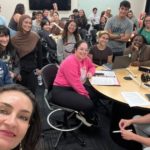 Students don’t drink wine at Ana Benaduce’s happy hours, and they don’t complain either. Instead, they come to relax and learn. Unlike typical happy hours at a bar, these events offer resources, not drinks, and instead of a bartender, students get one-on-one attention from their human anatomy professor.
Students don’t drink wine at Ana Benaduce’s happy hours, and they don’t complain either. Instead, they come to relax and learn. Unlike typical happy hours at a bar, these events offer resources, not drinks, and instead of a bartender, students get one-on-one attention from their human anatomy professor.
Before COVID-19, office hours were hit or miss—some students would drop by to ask questions or talk to their professors, but many didn’t bother. After the pandemic, attendance dropped even further. To address this, Benaduce wanted a fresh approach that would encourage more participation and engagement. Along with her co-teacher Lisa Brinn, she rebranded office hours as “happy hours” and moved them to a larger lab space.
Coming together
At these happy hours, there’s no bar and no alcohol—just conversation, camaraderie, and students. And thanks to Benaduce’s engaging teaching style and vibrant personality, her sessions have regular attendees. Known as WittyAnatomy on Instagram and YouTube, Benaduce has earned a following with her funny and clear explanations of tough material, making her a favorite among students.
Benaduce’s happy hours draw in large crowds. Her new approach has been so successful that she and Brinn published their findings in the Journal of College Science Teaching. Their study showed that this more flexible style of office hours led to better academic support, stronger peer connections, and improved student performance.
By creating an inclusive space where students can comfortably ask questions and help each other, Benaduce and Brinn are proving that office hours don’t have to be a dull experience. They’ve turned them into a welcoming, supportive environment where students can connect and learn. Cheers to that!